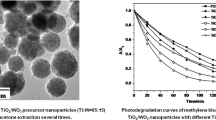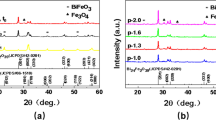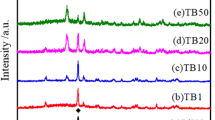Abstract
Nano-TiO2 is certainly the most studied semiconductor for environmental purposes. Here, a template synthesis using block copolymers is combined to Bi promotion to the purpose of enhancing the TiO2 photocatalytic activity by modulating the oxide surface area and porosity as well as by slowing down the electron–hole recombination. Three block copolymers of the Pluronic family, characterized by different micelle sizes in water as determined by light scattering analysis, are employed to induce mesoporosity in nano-TiO2. The surfactants are removed by combining UV and thermal treatments to avoid pore collapse while obtaining a good oxide crystallinity. A fine modulation of pore size and total volume is obtained by changing polymer type and concentration, effectively enhancing the ability of the oxide to promote the mineralization of methylene blue stains. The mesoporous oxides are then used as scaffolds to obtain Bi2O3–TiO2 composites. X-ray diffraction, N2 adsorption at subcritical temperatures, high-resolution transmission microscopy, Fourier transform infrared spectroscopy, and zeta potential determinations give insight on the composite structure and on the specificity of the Bi–mesoporous TiO2 composites with respect to traditional sol–gel TiO2 nanomaterials. All samples are tested for the photodegradation of methylene blue stains and of formic acid under dry and wet conditions, respectively. The presence of Bi promotes the photocatalytic activity of the final samples in both tested reactions (about 30 % mineralization enhancement with respect to unpromoted TiO2). The top performing photocatalyst is the Bi2O3–mesoporous TiO2, which shows the largest recombination time of photogenerated electrons and holes as determined by photocurrent measurements.








Similar content being viewed by others
References
Alexandridis P, Hutton TA (1995) Poly(ethylene oxide)–poly(propylene oxide)–poly(ethylene oxide) block-copolymer surfactants in aqueous-solutions and at interfaces—thermodynamics, structure, dynamics, and modeling. Colloids Surf A 96:1–46. doi:10.1016/0927-7757(94)03028-X
Alexandridis P, Holzwart JF, Hatton TA (1994) Micellization of poly(ethylene oxide)–poly(propylene oxide)–poly(ethylene oxide) triblock copolymers in aqueous-solutions—thermodynamics of copolymer association. Macromolecules 27:2414–2425. doi:10.1021/ma00087a009
Alexandridis P, Nivaggioli T, Hatton TA (1995) Temperature effects on structural-properties of pluronic P104 and F108 PEO–PPO–PEO block-copolymer solutions. Langmuir 11:2847–2848. doi:10.1021/la00007a085
Angelome P, Andrini L, Calvo ME, Requejo FG, Bilmes SA, Soler-Illia GJAA (2007) Mesoporous anatase TiO2 films: use of TiK XANES for the quantification of the nanocrystalline character and substrate effects in the photocatalysis behavior. J Phys Chem C 111:10886–10893. doi:10.1021/jp069020z
Ardizzone S, Bianchi CL, Cappelletti G, Naldoni A, Pirola C (2008) Photocatalytic degradation of toluene in the gas phase: relationship between surface species and catalyst features. Environ Sci Technol 42:6671–6676. doi:10.1021/es8009327
Ardizzone S, Cappelletti G, Meroni D, Spadavecchia F (2011) Tailored TiO2 layers for the photocatalytic ozonation of cumylphenol, a refractory pollutant exerting hormonal activity. Chem Commun 47:2640–2642. doi:10.1039/c0cc05134a
Barrett EP, Joyner LG, Halenda PH (1951) The determination of pore volume and area distributions in porous substances. I. Computations from nitrogen isotherms. J Am Chem Soc 73:373–380. doi:10.1021/ja01145a126
Bates FS, Fredrickson GH (1999) Block copolymers—designer soft materials. Phys Today 52:32–38. doi:10.1063/1.882522
Bian ZF, Zhu J, Wang SH, Cao Y, Qian XF, Li HX (2008) Self-assembly of active Bi2O3/TiO2 visible photocatalyst with ordered mesoporous structure and highly crystallized anatase. J Phys Chem C 112:6285–6286. doi:10.1021/jp800324t
Bleta R, Alphonse P, Lorenzato L (2010) Nanoparticle route for the preparation in aqueous medium of mesoporous TiO2 with controlled porosity and crystalline framework. J Phys Chem C 114:2039–2048. doi:10.1021/jp909646h
Boiadjieva T, Bianchi CL, Cappelletti G, Ardizzone S, Rondinini S, Vertova A (2004) The role of surface electrification on the growth and structural features of titania nanoparticles. Phys Chem Chem Phys 6:3535–3539. doi:10.1039/b402370f
Bosc F, Ayral A, Albouy PA, Guizard C (2003) A simple route for low-temperature synthesis of mesoporous and nanocrystalline anatase thin films. Chem Mater 15:2463–2468. doi:10.1021/cm031025a
Brinker CJ, Lu Y, Sellinger A, Fan H (1999) Evaporation-induced self-assembly: nanostructures made easy. Adv Mater 11:579–585. doi:10.1002/(SICI)1521-4095(199905)11:7<579:AID-ADMA579>3.0.CO;2-R
Carp O, Huisman CL, Reller A (2004) Photoinduced reactivity of titanium dioxide. Progr Solid State Chem 32:33–117. doi:10.1016/j.progsolidstchem.2004.08.001
Choi SY, Mamak M, Coombs N, Chopra N, Ozin GA (2004) Thermally stable two-dimensional hexagonal mesoporous nanocrystalline anatase, meso-nc-TiO2: bulk and crack-free thin film morphologies. Adv Funct Mater 14:335–344. doi:10.1002/adfm.200305039
Crepaldi EL, Soler Illia GJDAA, Grosso D, Castagnol F, Ribot F, Sanchez C (2003) Controlled formation of highly organized mesoporous titania thin films: from mesostructured hybrids to mesoporous nanoanatase TiO2. J Am Soc 125:9770–9786. doi:10.1021/ja030070g
de Boer JH, Lippens BC, Linsen BG, Broekhof JCP, van den Heuvel A, Osinga TJ (1966) Thet-curve of multimolecular N2-adsorption. J Colloid Interface Sci 21:405–414. doi:10.1016/0095-8522(66)90006-7
Dholam R, Patel N, Santini A, Miotello A (2010) Efficient indium tin oxide/Cr-doped-TiO2 multilayer thin films for H2 production by photocatalytic water-splitting. Int J Hydrogen Energy 35:9581–9590. doi:10.1016/j.ijhydene.2010.06.097
Di Paola A, Marcì G, Palmisano L, Schiavello M, Uosaki K, Ikeda S, Ohtani B (2002) Preparation of polycrystalline TiO2 photocatalysts impregnated with various transition metal ions: characterization and photocatalytic activity for the degradation of 4-nitrophenol. J Phys Chem B 106:637–645. doi:10.1021/jp013074l
Hagfeldt A, Lindström H, Södergren S, Linquist S-E (1995) Photoelectrochemical studies of colloidal TiO2 films—the effect of oxygen studied by photocurrent transients. J Elecroanal Chem 381:39–46. doi:10.1016/0022-0728(94)03622-A
Hecht E, Hoffmann H (1995) Kinetic and calorimetric investigations on micelle formation of block-copolymers of the poloxamer type. Colloids Surf A 96:181–197. doi:10.1016/0927-7757(94)03044-Z
Jing L, Wang J, Qu Y, Luan Y (2009) Effects of surface-modification with Bi2O3 on the thermal stability and photoinduced charge property of nanocrystalline anatase TiO2 and its enhanced photocatalytic activity. Appl Surf Sci 256:657–663. doi:10.1016/j.apsusc.2009.08.037
Kadam Y, Yerramilli U, Bahadur A, Bahadur P (2011) Micelles from PEO–PPO–PEO block copolymers as nanocontainers for solubilization of a poorly water soluble drug hydrochlorothiazide. Colloids Surf B 83:49–57. doi:10.1016/j.colsurfb.2010.10.041
Kosmulski M (2009) Compilation of PZC and IEP of sparingly soluble metal oxides and hydroxides from literature. Adv Colloid Interface Sci 152:14–25. doi:10.1016/j.cis.2009.08.003
Lee ES, Oh YT, Youn YS, Nam M, Park B, Yun J, Kim JH, Song H-T, Oh KT (2011) Binary mixing of micelles using Pluronics for a nano-sized drug delivery system. Colloids Surf B 82:190–195. doi:10.1016/j.colsurfb.2010.08.033
Little LH (1966) Infrared spectra of adsorbed species. Academic Press, London
Long R, English NJ (2009) Synergistic effects of Bi/s codoping on visible light-activated anatase TiO2 photocatalysts from first principles. J Phys Chem C 113:8373–8377. doi:10.1021/jp900589k
Magnacca G, Cerrato G, Morterra C, Signoretto M, Somma F, Pinna F (2003) Structural and surface characterization of pure and sulfated iron oxides. Chem Mater 15:675–687. doi:10.1021/cm021268n
Meroni D, Ardizzone S, Cappelletti G, Oliva C, Ceotto M, Poelman D, Poelman H (2011) Photocatalytic removal of ethanol and acetaldehyde by N-promoted TiO2 films: the role of the different nitrogen sources. Catal Today 161:169–174. doi:10.1016/j.cattod.2010.08.013
Milanesi F, Cappelletti G, Annunziata R, Bianchi CL, Meroni D, Ardizzone S (2010) Siloxane-TiO2 hybrid nanocomposites. The structure of the hydrophobic layer. J Phys Chem C 114:8287–8293. doi:10.1021/jp1014669
Morterra C, Bolis V, Fisicaro E (1989) The hydrated layer and the adsorption of co at the surface of TiO2 (anatase). Colloids Surf 41:177–188. doi:10.1016/0166-6622(89)80051-4
O’Regan B, Moser J, Anderson M, Grätzel M (1990) Vectorial electron injection into transparent semiconductor membranes and electric-field effects on the dynamics of light-induced charge separation. J Phys Chem 94:8720–8726. doi:10.1021/j100387a017
Paoli E, Cappelletti G, Falciola L (2010) Electrochemistry as a tool for nano-TiO2 deposition and for photoremediation pollutant monitoring. Electrochem Commun 12:1013–1016. doi:10.1016/j.elecom.2010.05.012
Perry CC, Sabir TS, Livingston WJ, Milligan JR, Chen Q, Maskiewicz V, Boskovic DS (2011) Fluorescence of commercial Pluronic F127 samples: temperature-dependent micellization. J Colloid Interface Sci 354:662–669. doi:10.1016/j.jcis.2010.10.028
Rouquerol J, Rouquerol F, Sing KSW (1999) Adsorption by powders and porous solids. Academic Press, London
Saadoun L, Ayllon JA, Jimenez-Becerril J, Peral J, Domenech X (2000) Synthesis and photocatalytic activity of mesoporous anatase prepared from tetrabutylammonium–titania composites. Mater Res Bull 35:193–202. doi:10.1016/S0025-5408(00)00204-X
Sanchez C, Boissière C, Grosso D, Laberty C, Nicole L (2008) Design, synthesis, and properties of inorganic and hybrid thin films having periodically organized nanoporosity. Chem Mater 20:682–737. doi:10.1021/cm702100t
Shamaila S, Sajjad AKL, Chen F, Zhang J (2010) Bismuth-doped ordered mesoporous TiO2: visible-light catalyst for simultaneous degradation of phenol and chromium. Chem Eur J 16:13795–13804. doi:10.1002/chem.201001099
Spadavecchia F, Cappelletti G, Ardizzone S, Bianchi CL, Cappelli S, Oliva C, Scardi P, Leoni M, Fermo P (2010) Solar photoactivity of nano-N–TiO2 from tertiary amine: role of defects and paramagnetic species. Appl Catal B 96:314–322. doi:10.1016/j.apcatb.2010.02.027
Tadros T (2009) Polymeric surfactants in disperse systems. Adv Colloid Interface Sci 147–148:281–299. doi:10.1016/j.cis.2008.10.005
Tafalla D, Salvador P, Benito RM (1990) Kinetic approach to the photocurrent transients in water photoelectrolysis at n-TiO2 electrodes. Analysis of the photocurrent-time dependence. J Electrochem Soc 137:1810–1815. doi:10.1149/1.2086809
Taylor DJF, Thomas RK, Penfold J (2007) Polymer/surfactant interactions at the air/water interface. Adv Colloid Interface Sci 132:69–110. doi:10.1016/j.cis.2007.01.002
Tsui HW, Hsu YH, Wang JH, Chen LJ (2008) Novel behavior of heat of micellization of Pluronics F68 and F88 in aqueous solutions. Langmuir 24:13858–13862. doi:10.1021/la803272y
Tsui HW, Wang JH, Hsu YH, Chen LJ (2010) Study of heat of micellization and phase separation for Pluronic aqueous solutions by using a high sensitivity differential scanning calorimetry. Colloid Polym Sci 288:1687–1696. doi:10.1007/s00396-010-2308-5
Wang JS, Li H, Li HY, Zou C (2010) Mesoporous TiO(2−x)A(y) (A = N, S) as a visible-light-response photocatalyst. Solid State Sci 12:490–497. doi:10.1016/j.solidstatesciences.2009.12.01
Wu QL, Rankin SE (2011) Tuning the mesopore size of titania thin films using a polymeric swelling agent. J Phys Chem C 115:11925–11933. doi:10.1021/jp2021193
Xu H, Zhang L (2009) Controllable one-pot synthesis and enhanced photocatalytic activity of mixed-phase TiO2 nanocrystals with tunable brookite/rutile ratios. J Phys Chem C 113:1785–1790. doi:10.1021/jp8089903
Zana R, Marques C, Johner A (2006) Dynamics of micelles of the triblock copolymers poly(ethylene oxide)–poly(propylene oxide)–poly(ethylene oxide) in aqueous solution. Adv Colloid Interface Sci 123–126:345–351. doi:10.1016/j.cis.2006.05.011
Acknowledgments
The authors wish to thank Prof. G. D’Alfonso and Dr. M. Panigati of the University of Milan for the determination of the micelle size distribution of the different block copolymers. This research has been supported by the University of Milan Research Funds (FIRST, PUR).
Author information
Authors and Affiliations
Corresponding author
Electronic supplementary material
Below is the link to the electronic supplementary material.
Rights and permissions
About this article
Cite this article
Meroni, D., Pifferi, V., Sironi, B. et al. Block copolymers for the synthesis of pure and Bi-promoted nano-TiO2 as active photocatalysts. J Nanopart Res 14, 1086 (2012). https://doi.org/10.1007/s11051-012-1086-z
Received:
Accepted:
Published:
DOI: https://doi.org/10.1007/s11051-012-1086-z




